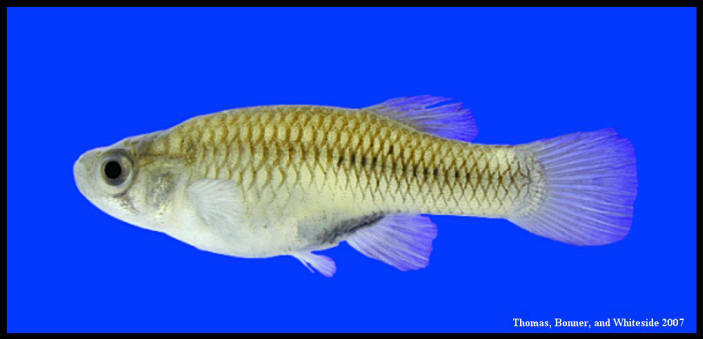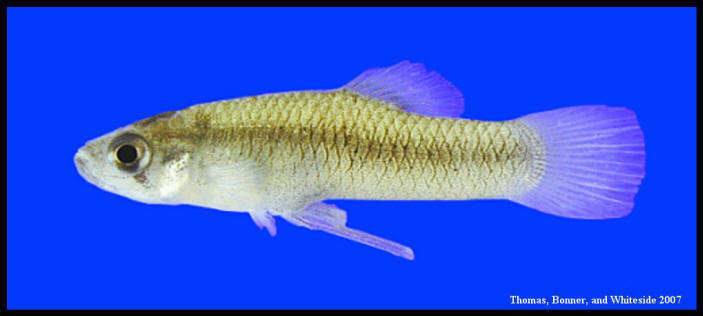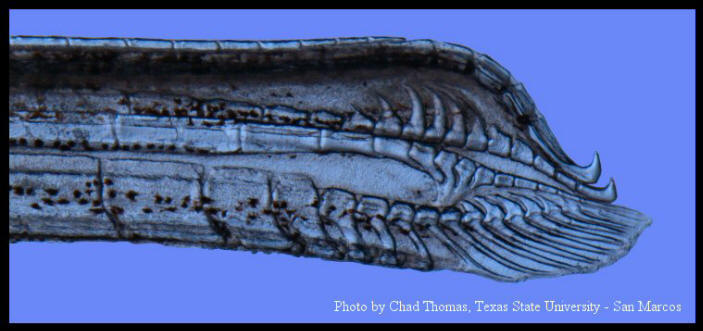|
|
||
|
Gambusia nobilis Pecos gambusia
THIS ACCOUNT IS IN PROCESS. PLEASE CHECK BACK LATER FOR ADDITIONAL INFORMATION.
Type Locality Leona and Comanche springs, Rio Grande del Norte, Texas (Baird and Girard 1853).
Etymology/Derivation of Scientific Name
Synonymy
Characters Maximum size: 48 mm TL (Page and Burr 1991).
Coloration: Postanal streak weaker than markings on scale pockets; dusky or no markings on mouth; no prominent spots in middle of caudal fin; a subbasal row of spots on dorsal fin; lateral stripe thin and threadlike; markings on sides rounded specks; dorsal and (in females) anal fins with yellow pigmentation (lost in preservation); mouth with dark markings or anal spot of females restricted to area immediately around anus; no dark bans on sides; median fins without large black spots near their bases (Hubbs et al. 2008).
Counts: Dorsal fin rays 7-8 (Hubbs et al. 2008).
Body shape: Dorsal fin origin well behind anal fin origin (Hubbs et al. 2008).
External morphology: Terminal hooks on 4th and 5th rays of gonopodium rounded at tip; tip of anterior branch of 4th ray of male gonopodium extends as far as tip of posterior branch; pectoral fin of males with slight indentation, shallower than widest pectoral fin ray; distal segments of anterior branch of 4th fin ray of gonopodium not coalesced to elbow; spines at tip of 3rd anal fin ray of male gonopodium 4-10 times longer than wide (Hubbs et al. 2008).
Internal morphology: Intestinal canal short with few convolutions (Hubbs et al. 2008).
Distribution (Native and Introduced) U.S. distribution: Scattered localities in western (Trans-Pecos) Texas and eastern New Mexico (Hubbs et al. 2008).
Texas distribution: Inhabits the headwaters of Phantom Lake (Jeff Davis County), San Solomon, Griffin, and East Sandia springs (Reeves County), Diamond Y Draw and Diamond Y Springs (Pecos County; Hubbs et al. 2008).
Abundance/Conservation status (Federal, State, NGO) State Endangered (Texas); Federally Endangered (Hubbs et al. 2008); originally, species also inhabited Leon Springs (type locality, roughly 16 km upstream from Diamond Y Springs) and Comanche Springs (within city of Fort Stockton, TX) prior to their desiccation (Hubbs et al. 2008). Listed as Endangered by the American Fisheries Society; status has declined since 1989; categories of threats: present or threatened destruction, modification, or reduction of habitat or range; and other natural or anthropogenic factors that affect the existence of this species, including impacts of nonidigenous organisms, hybridization, competition, and/or predation (Jelks et al. 2008). Guillory (1980) noted that Gambusia nobilis populations had been greatly depleted by G. affinis introductions and lowering of water table.
Habitat Associations Macrohabitat:
Mesohabitat: Typically inhabits shallow margins of clear vegetated spring waters high in calcium carbonate, although also found in more adverse sinkhole habitats (Guillory 1980).
Biology Spawning season:
Spawning habitat:
Spawning Behavior:
Fecundity:
Age at maturation:
Migration:
Growth and Population structure:
Longevity:
Food habits:
Phylogeny and morphologically similar fishes Gambusia nobilis closely related to the blotched gambusia (G. senilis); both species placed in G. nobilis species group (Hubbs and Springer 1957; Rivas 1963; Rosen and Bailey 1963; Guillory 1980).
Host Records
Commercial or Environmental Importance
References
Baird, S.F. and C. Girard. 1853. Descriptions of new species of fishes collected by Mr. John H. Clark, on the U. S. and Mexican Boundary Survey, under Lt. Col. Jas. D. Graham. Proceedings of the Academy of Natural Sciences of Philadelphia 6(7):387-390.
Bednarz, J.C. 1979. Ecology and status of the Pecos gambusia, Gambusia nobilis (Poeciliidae), in New Mexico. The Southwestern Naturalist 24(2):311-322. Guillory, V. 1980. Gambusia nobilis (Baird and Girard), Pecos gambusia. pp. 544 in D. S. Lee et al., Atlas of North American Freshwater Fishes. N. C. State Mus. Nat. Hist., Raleigh, i-r+854 pp.
Hubbs, C., and V.G. Springer 1957. A revision of the Gambusia nobilis species group, with descriptions of three new species, and notes on their variation, ecology and evolution. Texas Journal of Science 9(3):279-327.
Hubbs, C., and A.A. Echelle. 1972. Endangered and non-game fishes of the upper Rio Grande basin, pp. 147-167 in: Symposium on Rare and Endangered Fishes of the Southwestern United States. Dept. of Game and Fish, Santa Fe, New Mexico.
Hubbs, C., R.J. Edwards, and G.P. Garrett. 2002. Threatened fishes of the world: Gambusia nobilis Baird and Girard, 1853 (Poeciliidae). Environmental Biology of the Fishes 64:428.
Hubbs, C., R.J. Edwards, and G.P. Garrett. 2008. An annotated checklist of the freshwater fishes of Texas, with keys to identification of species. Texas Journal of Science, Supplement, 2nd edition 43(4):1-87. Jelks, H.L., S.J. Walsh, N.M. Burkhead, S. Contreras-Balderas, E. Diaz-Pardo, D.A. Hendrickson, J. Lyons, N.E. Mandrak, F. McCormick, J.S. Nelson, S.P. Platania, B.A. Porter, C.B. Renaud, J.J. Schmitter-Soto, E.B. Taylor, and M.L. Warren, Jr. 2008. Conservation status of imperiled North American freshwater and diadromous fishes. Fisheries 33(8):372-407.
Page, L. M. & B. M. Burr. 1991. A field guide to freshwater fishes of North America north of Mexico. Houghton Mifflin Company, Boston, Massachusetts. 432 pp. Peden, A.E. 1973. Variation in anal spot expression of Gambusiin females and its effect on male courtship. Copeia 1973(2):250-263.
Rivas, L.R. 1963. Subgenera and species groups in the poeciliid fish genus Gambusia Poey. Copeia 1963(2):331-347.
Rosen, D.E, and R.M. Bailey. 1963. The poeciliid fishes (Cyprinodontiformes): their structure, zoogeography, and systematics. Bull. Am. Mus. Nat. Hist. 126:1-176. |
||
|
|
||


